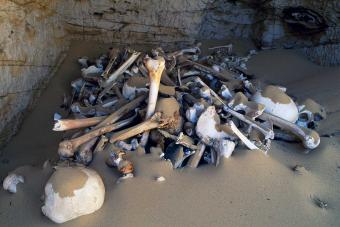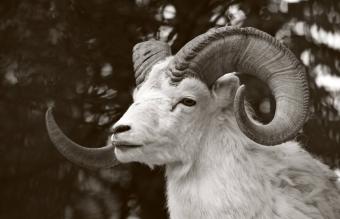
Ancient Egypt is perhaps best known for its burial practices and the lasting cultural sites like the pyramids and the Valley of the Kings, which preserve their mummified peoples and the artifacts of their daily life. However, the secrets that lay buried inside of these tombs hint at something much more sinister, something widely considered taboo today: Egyptian sacrifices.
Modern Myth Making and Ancient Egyptian Sacrifice
The Ancient world is a mysterious subject in human history, fascinating kids and adults alike for thousands of years. With a piecemeal historical record gathered from a fraction of the textual and physical evidence of their daily existence, it's no wonder that human curiosity has attempted to fill in the blanks of what life was like for early human civilization.
The human myth making machine has been known to create interesting tales of exploring dangerous creatures, mystical beings, and the macabre. Ritual and human sacrifice is one such mythical subject that's permeated conversations of the most popular Ancient cultures for decades, and Ancient Egypt isn't an exception.
When it comes to sacrifice in Ancient Egypt, there's a lot of debate among scholars, archaeologists, and historians as to how exactly this was practiced in their culture and to what extent it actually occurred. However, there is a consensus that both animal and human sacrifice did happen at various points in time across Ancient Egypt's history, and these specific periods offer unique insight into Ancient Egyptian religion, reverence, and leadership.
Retainer Sacrifice in the First Dynasty

The first evidence of human sacrifice found in Egypt comes from the kingdom's First Dynasty. This type of sacrifice, evidence of which is most readily found in the royal tombs of the First Dynasty's ruling elite, involved the Pharoah's most valuable aids, servants, and advisors being killed to continue servicing them in the afterlife. Known as retainer sacrifice, this practice slowly died out in the Second Dynasty, with little evidence proving that it continued.
King Hor-Aha
Archaeologists have been excavating King Aha's tomb in Abydos since the 1890s when Flinders Petrie first discovered it. King Aha was the second Pharaoh that ruled over a united Egyptian kingdom (following King Menes, who is said to have joined the Upper and Lower kingdoms under one rule), and he ruled during the country's First Dynasty.
During these excavations, there were dozens of subsidiary graves found just outside of the Pharaoh's funerary enclosure. All the bodies found inside were male, around the ages of 20-25 years old, and showed signs of strangulation. Due to the uniform age, archaeologists determined that these men must have all been killed at the same time, implying that they were sacrificed. Subsequent exploration at the tomb uncovered the tombs of artisans, courtiers, and other significant people, and a wealth of cultural and personal artifacts in their graves.
King Djer
King Djer succeeded King Aha, and when his tomb was unearthed over 559 individual satellite graves were discovered. Interestingly, King Djer's burial complex included a fair number of women, which contrasts with his predecessor's own protective fleet of young men. However, not all of these people were considered to be retainer sacrifices, with professionals only estimating that 99 of them were possibly sacrificed.
Retainer Sacrifice Dwindles in Later Rule
The archaeological evidence showing retainer sacrifice began to dwindle for the next few rulers that followed King Djer. For example, the following pharaohs had decreasing numbers of possible sacrificial burial sites in their tombs:
-
King Djet - A total of 174 satellite graves were found around this king's tomb, with only 99 of those being possible cases of retainer sacrifice.
-
Queen MerNeith - Queen MerNeith, who ruled as regent in her son's stead until he was old enough to ascend the throne, was buried with 41 surrounding individuals, with only 33 possible retainer sacrifices.
-
King Den - Queen MerNeith's son, King Den's, tomb had 83 possible retainer sacrifices among its 133 tombs.
-
King Semerkhet - King Semerkhet's burial enclosure is significant for its 68 subsidiary graves being housed under the same roof as the pharaoh, implying that the tombs were laid to rest in conjunction with the ruler's.
By and large, retainer sacrifice fell out of fashion across the kingdom by the end of the First Dynasty, though there were brief moments of its revival. For instance, the royal pyramid tombs located in Meroe that were established in post-Nubian rule around 270 BCE show some evidence of retainer sacrifice, but this didn't last for long.
Animal Sacrifice Was a Common Practice in Ancient Egypt

While retainer sacrifice was a practice almost exclusively enacted by the Egyptian elite (who could actually afford an entourage to have buried alongside them), many Egyptians were buried with their pets and livestock. What might seem like a cruel practice today was actually deeply rooted in Egyptian religious understanding of the afterlife.
Ancient Egyptians believed that a person's soul separated into two entities, the ba and ka after death. The ka was tied to the deceased's physical body, where it was housed (hence the need for mummification), but despite being bound to the body, the ka could move around and live a physical existence within the tomb. This meant that the ka needed to be nourished, given activities to do, games to play, servants to care for them, and so on. Thus, people didn't want to be deprived of their favorite pets in the afterlife, and so had them killed and buried alongside them.
Some of the common types of animals that have been found preserved in Egyptian tombs include cats, jackals, crocodiles, ibis, hawks, and many others.
Further Reading to Dig Deep Into Egyptian Sacrifice
While there's significantly more research out there about general Egyptian burial practices, there is some pertaining to the subject of sacrificial burials, as well as funeral rituals. Looking at these research materials can help offer a better understanding of Egypt's fascinating cultural heritage, and can offer greater insight into their cultural norms.
Yet, the best way to get an understanding of the Egyptian perspective on these practices is to go straight to the source, their Book of the Dead. The Egyptian Book of the Dead: The Complete Papyrus of Ani, translated by Ogden Goelet and Raymond Faulkner, is considered a great translation of the original papyrus and will open your mind to Egyptian burial and the afterlife.
Egyptian Practices That Should Remain Ancient History
Human past is filled with tales of triumph and tragedy, and the experiences detailed in Ancient Egyptian archaeology depict a society where death was sometimes doled out long before nature took its course. Out of all the beloved aspects of Egyptian culture that people want to emulate, burying your besties with you is one practice that should always remain buried deep in ancient history.







